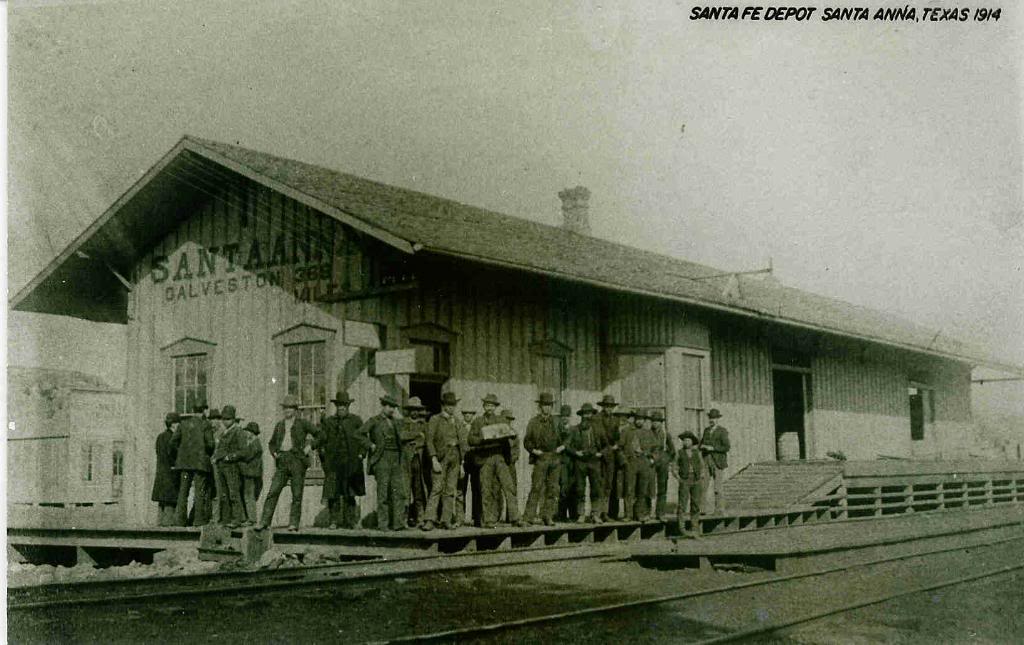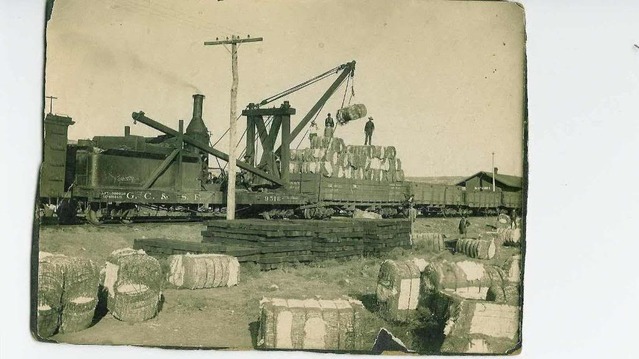Santa Anna Station Milepost 369+1436’
person could argue that the coming of the railroads is the single most important event in the history of Santa Anna, because it brought civilization.
The Gulf, Colorado, and Santa Fe Railway was incorporated in Galveston in 1873 and immediately began building lines to the frontier of Texas. After some serious financial difficulties were fixed, G.C.& S.F. lines reached Fort Worth in 1880. This captured the profitable cotton export trade of the central third of Texas for the port of Galveston.
Splitting off at Temple, the G.C.& S.F. cut across the state to the west in 1882. Company advertisements touted this western route as “the cattle route of Texas.” Pushing west, the line reached Brownwood in 1885 and Santa Anna in 1886, the same year the G.C.& S. F. was purchased by the Atchison, Topeka, & Santa Fe.
In May of 1886 G.C.&S.F. laid out a town site alongside its tracks which passed just south of Santa Anna’s Peaks, and the small community in the gap of the peaks soon picked itself up and moved. According to the September 1886 G. C. & S. F. payroll ledger the first agent at Santa Anna Station was Leroy V. Stockard. At first Stockard lived with his wife and young son Robert in W. C. Brooks two-story wood frame hotel in the gap. Stockard’s mother-in-law, Mary Lappington, described the scene she saw on a visit on April 14, 1886: “… a beautiful country with 25 to 30 homes and a nice two story hotel in the gap of the mountain with a splendid cook that made $40.00 a month and didn’t even wash the dishes.”
Stockard became a prominent citizen in this community as a deacon in the Baptist Church and otherwise. He built a large two-story rock store and opera house a block north of the depot and engaged in the local real estate business. He was railroad agent for several years, killed when struck by a switching freight train in the yard at Santa Anna on the evening of April 4, 1923, at 65 years of age.
Section Foreman B. H. Melton also settled here. The hotel in the gap had been disassembled and the lumber used to build the Walker Hotel just a block north of the depot. Melton bought the business and furnished meals there for railroad employees and passengers. As owner, Melton probably helped pay for some of the advertising about Santa Anna which began to appear in Galveston newspapers soon after the line was completed.
Santa Anna bragged of being a “healthy mountain resort” and “summertime escape” from the yellow fever and malaria that plagued the coastal country. By 1900, the Santa Fe itself was advertising the country between Santa Anna and San Angelo as “free from all miasmatic conditions.” In other words, it wasn’t humid.
When Santa Anna station closed in 1969 the last agent was Grady Wester. The tracks Wester saw carry people and freight in and out of Santa Anna are still in use today, but passengers no longer arrive or depart. Now cargo is all that moves through town, with just a blaring horn heard for miles around late in the night the only sign of its presence. I guess the railroad brought all the civilization it could. Now it just passes through.



